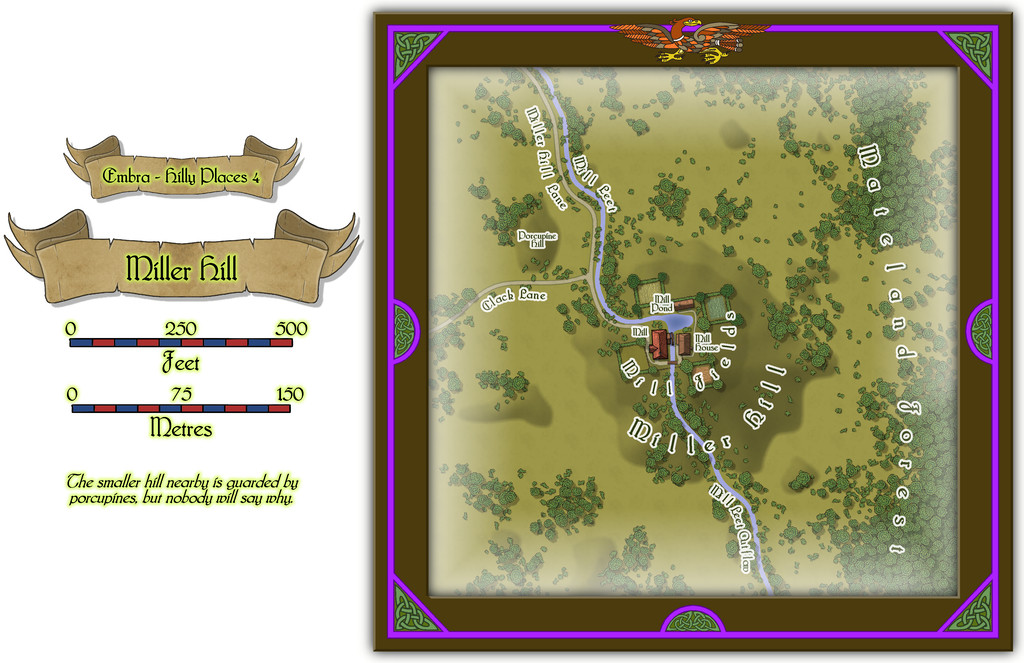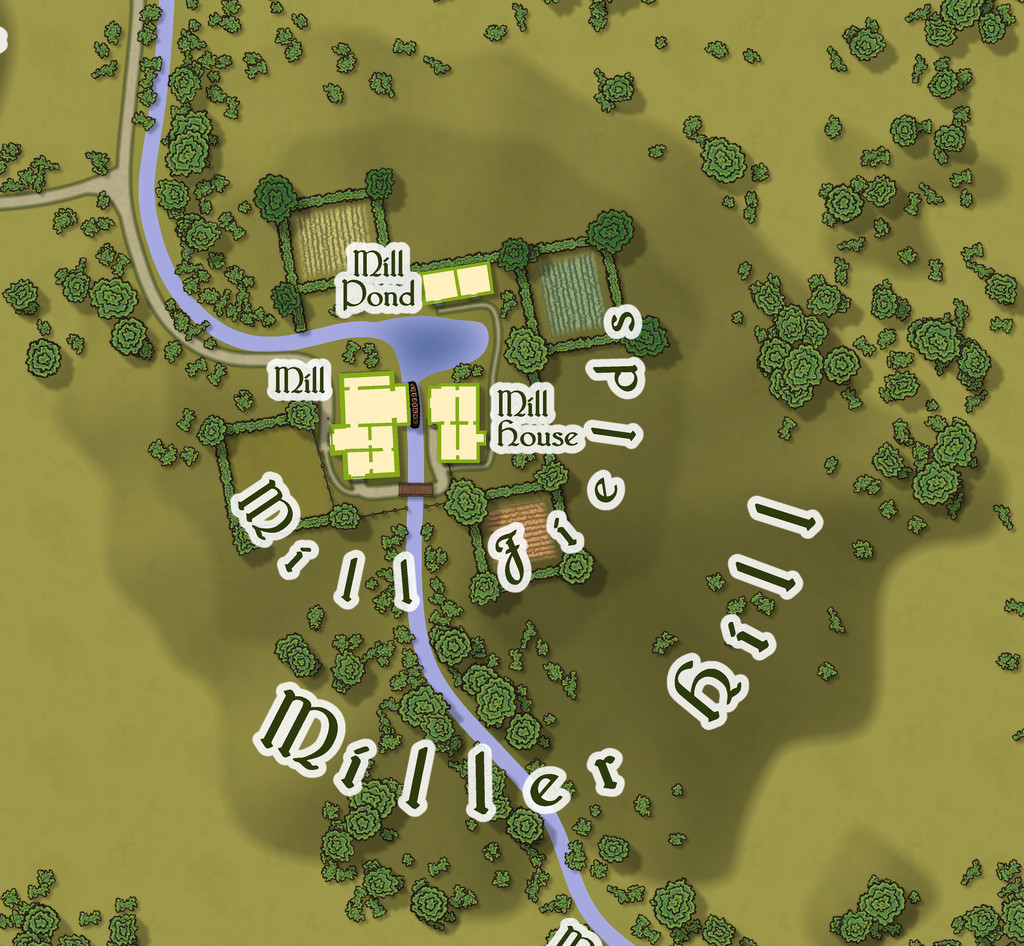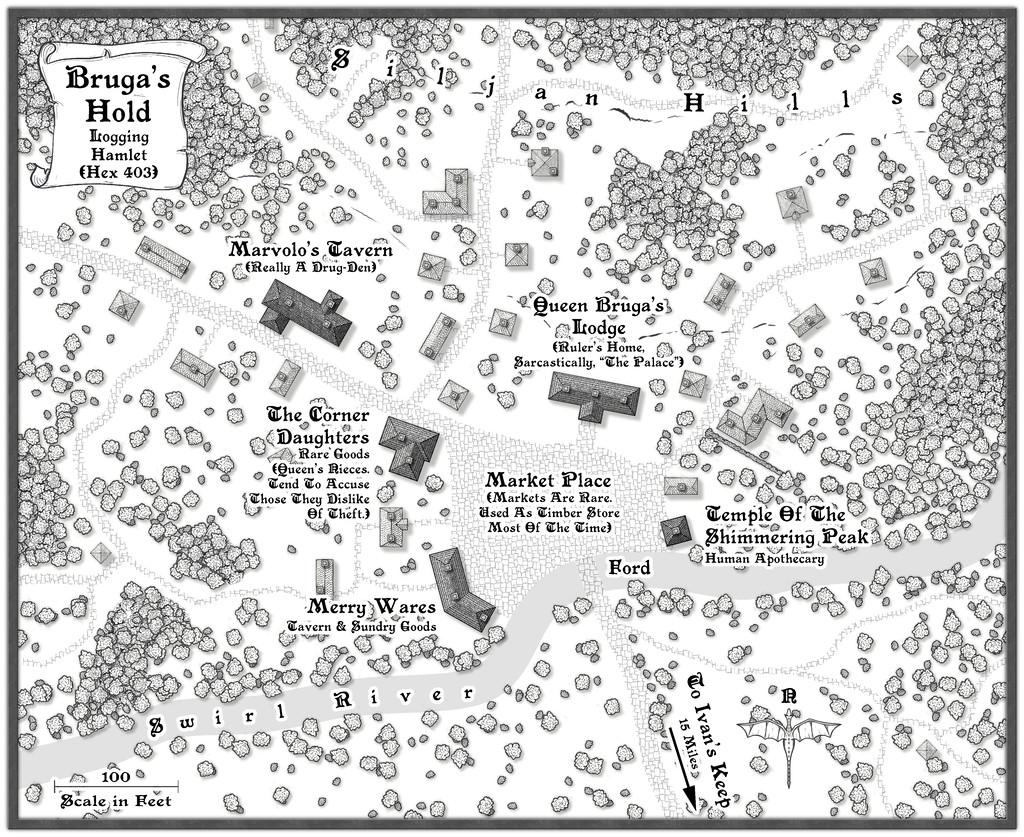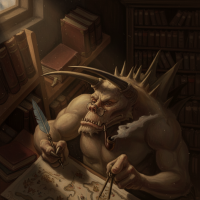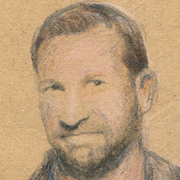
Wyvern
Wyvern
About
- Username
- Wyvern
- Joined
- Visits
- 3,140
- Last Active
- Roles
- Member
- Points
- 5,368
- Rank
- Cartographer
- Badges
- 24
-
Community Atlas: Embra - Hilly Places
Miller Hill as Place 4 seemed an obvious choice for a Hilly site. However, as stated already, y'know, Embra. So this is a water mill at the top of a hill, with a stream that runs uphill to the mill pond on the summit, runs the water wheel, and then descends down the other side of the hill again! Naturally, no one here thinks this is anything unusual - how could the mill run without a water source, is the primary response to those who might seek to question the setting:
There are some buildings on this map too, for once in the "Hilly" selection, which have interiors that can be viewed using the toggle in the FCW file in the Atlas, all being well:
It has to be said I was delighted to see the random base map options had provided one that so obviously fitted the nature of a mill site of this, shall we say unusual, kind - those four square fields looking like the sails on a windmill. So there's a note in the PDF and text files for this map suggesting GMs could have the four fields, and their hedge/fence lines, rotate, flowing over the land surface like cloth, carrying anyone in one of the fields along with them, but only when the wind blows strongly. Everything else of course stands quite still; and not entirely by chance, the rotation centres more or less on the axle of the mill-wheel, where else?
-
Using Watabou generators to creat a campaign.
-
CA style development - "Darklands City" (issues for September and December 2021)
@JulianDracos noted: ...I am interested in Hobbit house symbols. I have found a way/map style that I can do OK to demonstrate it is a Hobbit style home city, but I do not have anything for the city level view.
SS5 Cities of Schley has a selection of Halfling house options (grassy mounds with round doors and windows), and also Elven treehouses, plus rough-looking Orc buildings. The main CD3 Bitmap B style has a larger range of fantasy building options as well, including for Halflings (houses and grassy mounds) and Elven treehouses again, as do the main CD3 vector styles, so there are options there without needing to go down the Annuals route. And the Annuals, being smaller in size than these main products, do tend to concentrate more on providing the basic styles first.
It is worth noting that you can draw your own house shapes using the CD3 toolset, and give the roofs whatever texture you wish from the range of options you have available. Stacking different shapes on top of one another on different Sheets with variant Effects can also increase the options for how things appear. DIY treehouses by placing a suitably-shaped and textured house in different sized tree and other vegetation symbols, all on separate Sheets, for instance. And things like varicolor wooden roofs can be made to work as market stall awnings with a bit of resizing and choice of suitable colours.
Sorry for hijacking your thread, Sue! Can't really add much beyond what's already been suggested above for Darklands Cities II, after all that... 😪
-
[WIP] Community Atlas, 1,000 Maps Contest: Villages in The Whispering Wastes of Haddmark, Peredur
Map The Second is...
Hex 403, Bruga's Hold:
A logging hamlet on the upper Swirl River, among the woods of the southwestern Siljan Hills, this is a rather isolated, frontier-style settlement, with trails leading-off to logging camps, or former ones (the trails southeast of the river crossing were where much of the timber for the settlement originated, for instance). Markets here aren't common, but the open space is handy for storing piles of fresh timber prior to sending it off down-river, or overland by trail southwards. The self-styled Queen's tough, if not as young as she was, and her extended family keeps most things more-or-less in-check here, though her nieces at The Corner Daughters have a tendency to accuse those they dislike of theft, something that works best with outsiders. The grandiose apothecary's shop-name was a random choice (it does look outwardly like a small temple), which seemed too apt to waste - see the notes above on the Crystal Cathedral - while "Merry Wares" became something of a running joke, as it cropped up randomly twice more in different settlements in this set for quite different places. I retained that too, as GMs can decide if it's at all significant.
On the original map, I started out with the woods rather denser than they are now. That looked much too dominant, and would have been unrealistic so near the settlement, so, much like the original loggers here, I had to thin them out somewhat. The mapping style makes use of both tree and bush symbols, and a bitmap tree fill drawing tool, which in combination for the densest areas here help give the woods a particularly 3D feel, although the symbols have to be applied judiciously to better hide the edges of the bitmap-fill segments. Of course, I had to delete and redraw all the first areas of the fill, as they were far too large, and it took a little experimenting to get the sizes right after that, in combination with the individual scatter of trees and bushes. Luckily, I had a fair idea of how best to achieve all this, as - although it was using a somewhat different style, and in colour - I have done quite a bit of woodland mapping for the Atlas before, for those who remember the extensive mapping series for the Faerie City of Embra - like the Wooded Places maps.
-
WIP Crofton - Darklands Cities and Shassar Tutorials
@Loopysue commented: "No plans for a Darklands Dungeon just yet, but that's not to say it will never happen."
Overland, Cities and Dungeons are the three key planks for CC3+ mapping though, and it has been mentioned here now, so... 😎
-
[WIP] Community Atlas, 1,000 Maps Contest: Villages in The Whispering Wastes of Haddmark, Peredur
Place four is from Hex 805, Toresk Village:
A somewhat more conventional, "open", layout for the next village in this group compared with last time's Ivan's Keep, if with more potentially untoward locations this time, including an overt reference to The Shimmering Cult, to add a little more linkage between features across the maps in this Haddmark mapping extravaganza. Those who read through last time's PDF notes here will have learnt the Druids from Hex 611 had a hand in creating the defences at Ivan's Keep (and may be responsible for the Goblin attacks on the place too, while The Shimmering Cult may be behind the Kobold attacks there...). Here, no similar problems, just a variety of dubious or curious goings-on. The map notes, as usual, have a little more detail.
Even so, I wanted the layout to be a bit odd, since the random rolls in the Shadowdark tables had come up with a Chaotic nature for the settlement (for those unfamiliar, most things in this RPG can be assigned an alignment - Law, Neutral or Chaos - as a keyword for GMs to apply as they choose to provide variant atmospheres for different places). So the village began nearer the river as a planned layout, but as more people came here, it spread more haphazardly eastwards, such that the older properties are now rather run-down and ill-favoured, despite also having a neater street pattern and fancy road-end walls.
-
Wishlist for CC4
@Glitch - Something else you might try is having a second window with another program (such as Windows Explorer) on full screen mode, so it hides the CC3+ window completely. This helps stop the looping as much, and you can check the thumbnail view to see when the CC3+ screen is showing correctly again. I spotted Ralf did exactly this on this week's livestream at one point, so I know it's not just me who finds this helps sometimes!
-
How do i know what i currently have installed?
Go to CC3+, find the drop-down menu "Tools" in the bar along the top of the window, and then go to the "Add Ons" label in that drop-down. That will show you everything you have currently installed, and you can click on any one of those names to access each individual item's description in an HTML file.
-
The Expanse rpg; several starships, Annual scifi tiles and Cosmographer
My big problem with large ships is visualizing the layout/deck plans.
I forget whether you mentioned having a copy of any of the Metamorphosis Alpha RPG books or not now Jim, though I suspect from this comment probably not, as even the limited floorplans for the two complete decks, and the brief notes on all the others, in the first edition rules from 1976, would have given you a few pointers in this regard.
In one sense, Remy's right in suggesting it may help to think of the whole ship as like a huge city, actually more like a small country, given its gigantic size. Depending on how you envisage the entire craft as functioning, it's perfectly possible some of the decks might have a single function, or several major functions, each. Something like a farming deck for food production and air recycling, including breeding populations of domesticated animals, for instance, while there could be huge areas given over to parked-up machines on another deck for use on whatever planet the ship eventually reaches to colonise (since that's the primary reason such vast craft were envisaged originally). Elsewhere, there could be factories and machinery for use in them stored on another deck, again to get things functioning once the planet was reached, with maybe one entirely water-filled, for living aquatic foodstuffs, and as a water supply for the ship (could easily be segregated into fresh and sea water parts). Plus power supplies of varying kinds, of course.
It might help to work out what the total floor area is for the whole craft, and then compare that to a populated area on Earth somewhere, and see exactly what sort of features lie within a similar-sized zone, and what of those would be useful/essential on a ship destined to be in space for hundreds of years or more.
Hopefully in all this, we can help get you back on course!
-
Community Atlas: Towards a Solar System for Nibirum
Having been tasked with constructing a Solar System for the Community Atlas world of Nibirum, only a few things were clearly in-place at the outset. Expressed preferences, coupled with the nature of Nibirum as depicted in the surface maps and descriptions of the world itself so far, showed Nibirum to be an Earth-like planet in size and nature, including with seasonal effects and climatic zones, illuminated by a single Sol-type Sun. As noted before, I'd opted for a simplified 360-day year for the planet more or less from the start too. One, probably Luna-type Moon, was preferred at least (Quenten), although perhaps with one or more additional moons (Dogtag). I assumed impressive astronomical phenomena like solar and lunar eclipses would be required additionally, to provide Nibirum with extra flavour and reality. The solar eclipse factor gave a first physical parameter beyond the planet, since Earth-type total solar eclipses could only happen if one of Nibirum's moons had the same apparent size as its Sun.
The "multiple moons" question led me back to an idea I've played with previously in RPG settings, a variable effect or object usually seen in one part of the sky, when visible at all, which can become a convenient plot-device or subject of game-omen lore. I settled on a group of small cometary objects loosely "trapped" around the leading (L4) Lagrange point on Nibirum's orbit. The L4 and L5 Lagrange points on a body's orbit are gravitationally stable points where relatively small objects can become caught for very long periods (centuries to millennia). Their own pre-existing space-motions mean the objects usually continue to orbit about that stable point, so are not necessarily fixed in one spot. Each point lies more or less at 60° from the Sun as seen from the main body - such as a planet - forming one apex of a conveniently equilateral triangle, with the planet and Sun at the other two apices. This means, handily, that the planet's distance from its Sun is the same as the distance to either of these two Lagrange points. One lies 60° ahead of the Sun as seen from, say, Nibirum, the other 60° behind the Sun. Thus objects around Nibirum's leading Lagrange point would be visible close to the ecliptic in the morning sky before sunrise. So these little comets quickly became the Phoenix Asteroids Dawn Heralds.
Leaving the L5, trailing, Lagrange point empty - at least of anything visible from the surface of Nibirum - opens the door to scholarly speculation on the planet by those seeking symmetry. So maybe the misty stars of the Dawn Heralds shine showing the approaching richness (or otherwise) of the magical-mystical potential into which Nibirum will soon be moving (for a 360-day year, 60° = 60 days on Nibirum). That there is no equivalent group of Dusk Heralds could suggest that potential has been exhausted by the passage of the magical world of Nibirum, and will take much time - most of a year, say - to recover.
However, fitting a second, much smaller moon into the trailing Lagrange point on the orbit of Nibirum's main Moon seemed an ideal reworked symmetry, which also gave the planet more than one natural satellite. (The Lagrange point geometry is the same for the lunar orbit. Just substitute "Nibirum" for "Sun", and "main Moon" for "Nibirum" and "the planet" in the earlier description.) Thus was born the Red Moon, always faithfully following the larger White Moon around the sky. Not quite Gloranthan, though with names ultimately inspired by that fantasy world, via the old "White Bear, Red Moon" board wargame name, later revised as "Dragon Pass". Still more perfectly, and following from typical Earthly precedents of similar celestial behaviour, this can also be called the Dog Moon. So naturally, another name for the White Moon had to be the Q Moon (only from Nibirum's southern hemisphere, however, and then only by societies that recognise the significance of the apparent pattern forming said letter on the lunar disc).
Then 'twas time to see what else lay beyond Nibirum. There are of course numerous random solar system generators available for RPG use. Given the experimental nature of the whole Night Sky for Nibirum concept, I decided on one I've had for a while, but never used this way before, Galactic Baroque's "Instant Universe" (available for purchase via DriveThru RPG). This proved interesting, if not quite so straightforward, rapid, or complete as its name might imply.
Needing a Sol-like Sun, and given there is some scholarly debate still as to whether Earth's Sun is spectral type G2 or G4, I went with a class G3 sun of standard stellar type for Nibirum. That means it has sunspots from time to time, and a solar wind able to produce polar and sometimes mid-latitude aurorae, just as we see from Earth. At one solar mass, it seemed sensible to also go with a similar size to our Sun, thus Nibirum's Sun has a diameter of 1,400,000 kilometres (Sol's is 1,392,530 km; if you want miles, divide by 1.6).
Dicing on the Instant Universe tables provided the System with seven planets, their distances from the Sun, masses, sizes, natural satellites and so forth. Some of these features were slightly reworked or rounded-off to give a Solar System a little less mathematically-challenging for GMs to work with, and a few parameters not given by Instant Universe were added. The obvious place to fit Nibirum into this scheme was as the third planet outwards from the Sun, because that had a rounded distance of 130 million km, not far from Earth's own circa 150 million km.
Next came a series of calculations to find out what of all this could be seen from Nibirum. The Sun has an angular size of 0.62° from the planet (Sol is about 0.5° as seen from Earth), so that decided what minimum angular size the Q Moon needed to be to produce total eclipses for Nibirum. A diameter of 2,130 km at 200,000 km from Nibirum did the trick, with an option (just like for Earth) to have the lunar orbit's centre be slightly offset from Nibirum's centre, so the lunar disc can be sometimes a little too small to completely block the Sun, producing not-quite-total annular eclipses occasionally. Random rolls came up with a Dog Moon size of 350 km, so showing a tiny, faint, red disc about 0.1° in diameter as seen from the planet. The human eye can resolve objects as small as roughly 0.07°, so this is quite near that limit. No other planet appears as anything other than a bright to extremely brilliant star to the unaided eye from Nibirum.
I wanted the Dawn Heralds to be quite easily visible sometimes from the planet, despite no individual object within them being brighter than a 3rd magnitude star - and that only very occasionally. So I decided on them appearing as a somewhat nebulous patch, with at most a few brighter (4th or 5th magnitude) star-like points within, which collectively should be roughly 0.5° to 1.5° across as seen from Nibirum. This equates to a physical cross-sectional area of around 1 to 3½ million km or so, an actual size easily achievable by one quite modest comet of the kind visible from Earth. Such an angular size is similar to that of the Earth-visible Pleiades star cluster of 9 or 10 mostly 4th and 5th magnitude stars in the constellation of Taurus the Bull, about 1° east-west by 0.7° north-south. Despite the relative faintness of its stars (only one is 3rd magnitude), this cluster is a surprisingly easy object for the unaided eye in even quite strong twilight. The proximity of the stars to one another seems to make it easier to spot than just their brightnesses alone might indicate, so the Dawn Heralds can have a similar ability to "tickle" the vision of Nibirese morning sky-watchers.
Choosing what to depict on maps from all this, and how to do so, was somewhat more of a challenge. As I don't have Cosmographer installed, mapping came down to a choice between two main Annuals, CA 22 (October 2008) Star Systems or CA 80 (August 2013) HighSpace Star Systems. CA80 has a greater range of planet symbol options, and I needed two ringed planets, but in the end, CA22 just won out, as despite it having no ringed planet symbols, it did have the option for dynamic lighting effects on its planetary discs. Moreover, CA22's Mapping Guide includes a short tutorial on creating your own planet symbols with said dynamic lighting.
Thus with help from the GIMP (with which I freely confess I am a veritable novice), and still more from the Great and Powerful Monsen (who kindly allowed me to extract from his rotating-world graphics, and provided new, FT-generated, north and south polar views of Nibirum for the purpose), I constructed a small group of dynamic-lighting Nibirum planet symbols for use with the Atlas, one set showing six views of just the world, the other half-dozen onto which I GIMP-added some airbrushed white cloudy shapes, to make it look a little more homely.
[Image_10639]
After further deliberation, I decided on one chart to show the relative sizes and orbital distances of the planets, and a set of maps to show the satellites and features for each planet.
The relative-scale Solar System chart:
[Image_10640]
The five planet and satellite description maps:
[Image_10641]
[Image_10642]
[Image_10643]
[Image_10644]
[Image_10645]
Many of the details provided on these maps (collected with some further notes in a PDF to accompany them in the Atlas) cannot be discerned from Nibirum. However, I decided to preserve everything that had been randomly rolled or otherwise chosen, partly for the sake of completeness, partly because in some fantasy settings, there are ways of travelling to other planets - the classic sailing ships of the stars in some earlier incarnations of D&D, for instance. It seemed thus a useful adjunct to include this information for any who might wish to explore the Nibirum system more fully.
After that, I constructed some extra charts to help RPG GMs especially keep track of what's visible, where and when in Nibirum's night sky, starting with those Moons.



